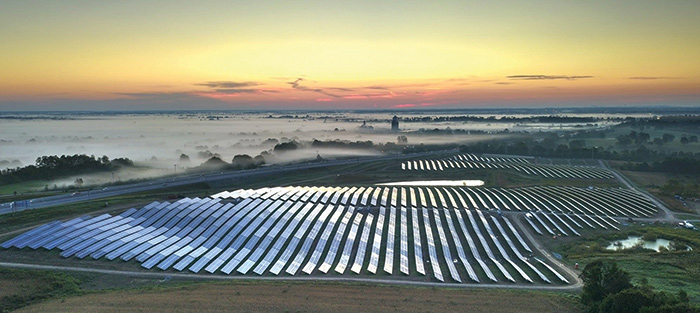
House Bill 227 – legislation that would have significantly changed one of the most important laws relating to solar energy in Kentucky – took as many twists and turns during the 2018 General Assembly as a country road, but ultimately came to an abrupt halt. It died on the last day of the session, but strong opinions about solar energy and its future in Kentucky live on.
While solar energy, even with tax incentives, remains more expensive for consumers than what the electricity utilities provide, the difference is narrowing. Wholesale solar-panel costs are declining 10 to 15 percent every year.
Importantly, if homes and businesses with solar systems are generating more power than they are using when the sun is shining, the excess feeds into the power grid and their meter runs backward, which credits or compensates them at their retail rate.
Utilities that build, maintain and operate the electric grid system pay out money to homes or businesses whose solar panel systems generate more power in a month than they use.
At the heart of the compensation process is “net metering,” and HB 227 would have redefined it, generally shifting the fundamental formulas from retail to wholesale. The rates of compensation and who sets those rates could change dramatically.
Many states have net metering laws. These laws vary widely, and those differences mean the benefits of using and generating solar power can vary widely for customers in different areas of the country.
- Sign up for The Lane Report business newsletter. Receive breaking Kentucky business news and updates daily. Click here to sign up
Net metering compensation rates are a key cost-analysis factor today for consumers assessing whether to purchase home and business solar-panel systems. That makes it crucial also to the growing industry of businesses that sell solar panels and systems – an industry that expects demand to grow greatly in the next decade if current trends on energy costs and environmental impacts continue.
The net metering debate going on currently is viewed as a proxy fight over who will be around to meet that future demand, how the costs of grid operation will be distributed, and who will have a say in setting electricity rates.
We asked four leaders in this field to offer their perspective on where we should go now with solar energy. Two represent Kentucky’s largest utilities, and two represent business entrepreneurs who have staked a claim in this increasingly important industry.
Solar Energy: A maturing technology that offers real value
By Nick Comer, External Affairs Manager, East Kentucky Power Cooperative
Solar and other renewables are important to a well-balanced energy portfolio and will continue to be in the future.
Over the last few years, the U.S. has seen solar energy installed at a rising rate. These installations – including our cooperative’s 60-acre Cooperative Solar Farm One in Winchester – clearly demonstrate solar is a maturing technology that offers real value, especially for consumers who demand clean-energy alternatives.
The community solar approach of Cooperative Solar has been well-received by consumers seeking assurance that energy for their home or business is clean and green.
In a world that demands reliable, affordable energy every moment of every day, it is important to understand the capabilities and limitations of each generating technology. Solar has its benefits, including free sunshine to fuel energy generation. But it also has its limitations, especially the fact that no energy is generated when the sun is not shining.
Utility-scale battery storage, still in development, could tremendously improve solar’s prospects. But fundamental hurdles of cost and reliability remain. It is unclear whether those hurdles can be overcome in the next few years or if we are a decade or more away.
Furthermore, Kentucky policy-makers must address the net metering statute to fix the cost-shifting that results from private solar installations being credited at full retail rates while avoiding costs of grid resources necessary for 24/7 service. As private solar grows in prevalence in Kentucky, this cost-shifting will become a rapidly growing burden for the majority of energy consumers who choose not to self-generate.
Incentivize the growth of solar in Kentucky
By Jamie Clark, President, Synergy Home
Arguably, solar energy for residential homes in Kentucky is almost nonexistent. We are only adding five to seven houses on average each month. Solar energy is still in its infancy in Kentucky and needs help to grow. In my opinion, not enough people care to fight back against legislation designed to kill residential solar, legislation like what we just saw in the last legislative session.
What we need to do is incentivize the growth of solar in Kentucky. We could use state tax rebates similar to those at the federal level. New York state added a 20 percent state credit to the 30 percent federal credit, basically allowing homeowners to add solar at 50 percent of retail cost. Kentucky has a lot more sunshine than New York, but they are beating the pants off of us in solar. Now we are 46th to 48th in solar growth, largely from lack of legislative leadership encouraging a progressive energy portfolio. We can do so much better.
Also, it is not currently legal in Kentucky to do third-party leasing. If we allowed that we would see steady solar growth. A company like Elon Musk’s Solar City could come in and lease the solar unit to you for 20 years. This gives people who may or may not have the ability to afford a solar system a way to do so on a long-term financing plan. The payment for solar would be just 70 percent of their utility bill. As utility rates rise, this percentage goes up. It would also help those Kentuckians having a hard time paying their utility bill.
At the commercial level, we passed EPAD (Energy Project Assessment Districts) a few years ago. This allows commercial businesses to finance energy measures on their property tax bill. The property rather than the individual gets hit with the liability, so the note stays with the property when sold and keeps the homeowners’ credit out of the transaction. The government needs to open new channels for innovation like this, not stop progress.
Individually customized solar facilities for business are available now
By Daniel Lowry, Media Relations Manager, LG&E and KU
Customers are increasingly interested in renewable energy options that support their needs. To help them meet those needs, LG&E and KU offer multiple options, including our Business Solar and Solar Share programs.
Through the Business Solar Program, LG&E and KU will build, own and operate individually customized solar facilities for interested businesses and industrial customers on their properties. In May, we just unveiled the program’s inaugural project, which partnered to operate the first diocesan-based solar array in the greater Kentucky area at the Archdiocese’s Pastoral Center and headquarters in Louisville.
The Solar Share Program allows both business and residential customers, including renters, to support local solar that powers our community. The program is ideal for those who want to support local solar energy but are unable to install it on their own property.
Because power from the sun’s energy is not always available, LG&E and KU maintain a diverse portfolio of generation options. These include our 10-megawatt facility at the E.W. Brown Generating Station in Mercer County, which is the largest universal solar facility in the commonwealth, as well as our Dix Dam and Ohio Falls hydro-powered generating stations.
Visit lge-ku.com for more information on our renewable energy generating stations and offerings.
Many issues to answer to arrive at fair rate structure
By John Cotten, General Manager, Wilderness Trace Solar
Looking into the future for renewable energy in Kentucky, the most obvious issue at the moment is net metering. What needs to be done to make an equitable rate for all the for-profit utilities, the member-owned co-ops – which are typically 501(c)(12)-status companies – and those individuals and commercial venues that produce renewable power?
At this time, the only extra hardware investment to the utilities in the production of renewable power from rooftop or other renewable venues of 30 kilowatts or less (the current net metered cap for renewable power generation) is the installation of a net meter on the facility to read the power purchased and the production power sent to the grid. All other equipment that is on the grid is there as part of the current electrical service.
Under the current billing systems, the utilities have said there are additional operational costs that are included in the consumers’ electric bills that are not categorized, but added into the overall price per kWh on our bills. This is in addition to the base charge all customers pay to be hooked up to the electric grid; and therein is the problem. No two utilities in Kentucky use the same rate calculations for billing to their customers.
Each has a separate negotiated rate with the Public Service Commission, each has a separate cost and operational structure, and each has a different view of the value of renewable energy to their operations. Until those actual added-in costs of operations are brought to the table and the actual benefit values of time-of-day generation from renewables are calculated into the rate-factoring equation, it is not likely the consumer will see a fair rate for power produced and credited or purchased to the generator in the near future.
Issues including consumer generator rates and compensation for net metering; supply-side distribution; consumer power production; actual costs to the utility, actual per kWh profits; the added benefits from the production of renewable power for load-shedding; and supply-side management will continue to be problems for the foreseeable future until the utility companies with renewable installers and the solar-generator customers all sit down to work out a package that benefits all parties.
Do we need a green tariff rate as some suggest or a separate rate structure for renewable power generators? That is a question to be answered by our legislators, the PSC, and other stake holders.
One thing is for certain: At the Interim Joint Committee (House and Senate) on Natural Resources and Energy on June 7, each utility that spoke said renewables will play a larger role in future power generation. How will it be done? By distributed generation with production on hundreds of smaller-scale power generators, or by site-sourced utility-scale generation owned either by the power companies or third-party investors.
The last thing to keep in mind is that large storage cells (batteries) and electric vehicles are going to play a significant role in the future of power usage and production requirements within 10 years. How are the utilities going deal with the rate and power-production requirements with the advent of those technologies in the next decade? And what types of power generation will be the source for the requirements of those technologies? We need to find answers and solutions to these questions now rather than later.
Debra Gibson Isaacs is a correspondent for The Lane Report. She can be reached at [email protected].




















Add Comment